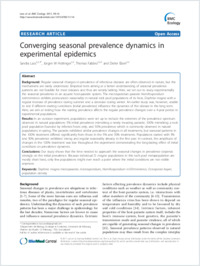Converging seasonal prevalence dynamics in experimental epidemics
- Lass, Sandra Départment de Biology, Ecologie et Evolution, Université de Fribourg, Switzerland - Zoological Institute, Evolutionary Biology, University of Basel, Switzerland - Department of General Pathology and Pathological Anatomy, Institute of Pathology, University Medical Centre, Albert-Ludwigs-University Freiburg, Germany
- Hottinger, Jürgen W. Départment de Biology, Ecologie et Evolution, Université de Fribourg, Switzerland - Zoological Institute, Evolutionary Biology, University of Basel, Switzerland
- Fabbro, Thomas Départment de Biology, Ecologie et Evolution, Université de Fribourg, Switzerland - Zoological Institute, Evolutionary Biology, University of Basel, Switzerland - Study Coordination Center, University Hospital Basel, Switzerland
- Ebert, Dieter Départment de Biology, Ecologie et Evolution, Université de Fribourg, Switzerland - Zoological Institute, Evolutionary Biology, University of Basel, Switzerland
-
17.05.2011
Published in:
- BMC Ecology. - 2011, vol. 11, p. 14
Daphnia magna
microparasite
microsporidium
Hamiltosporidium tvärminnensis
Octosporea bayeri
population density
English
Background Regular seasonal changes in prevalence of infectious diseases are often observed in nature, but the mechanisms are rarely understood. Empirical tests aiming at a better understanding of seasonal prevalence patterns are not feasible for most diseases and thus are widely lacking. Here, we set out to study experimentally the seasonal prevalence in an aquatic host-parasite system. The microsporidian parasite Hamiltosporidium tvärminnensis exhibits pronounced seasonality in natural rock pool populations of its host, Daphnia magna with a regular increase of prevalence during summer and a decrease during winter. An earlier study was, however, unable to test if different starting conditions (initial prevalence) influence the dynamics of the disease in the long term. Here, we aim at testing how the starting prevalence affects the regular prevalence changes over a 4-year period in experimental populations.Results In an outdoor experiment, populations were set up to include the extremes of the prevalence spectrum observed in natural populations: 5% initial prevalence mimicking a newly invading parasite, 100% mimicking a rock pool population founded by infected hosts only, and 50% prevalence which is commonly observed in natural populations in spring. The parasite exhibited similar prevalence changes in all treatments, but seasonal patterns in the 100% treatment differed significantly from those in the 5% and 50% treatments. Populations started with 5% and 50% prevalence exhibited strong and regular seasonality already in the first year. In contrast, the amplitude of changes in the 100% treatment was low throughout the experiment demonstrating the long-lasting effect of initial conditions on prevalence dynamics.Conclusions Our study shows that the time needed to approach the seasonal changes in prevalence depends strongly on the initial prevalence. Because individual D. magna populations in this rock pool metapopulation are mostly short lived, only few populations might ever reach a point where the initial conditions are not visible anymore.
- Faculty
- Faculté des sciences et de médecine
- Department
- Département de Biologie
- Language
-
- English
- Classification
- Biological sciences
- License
-
License undefined
- Identifiers
-
- RERO DOC 24830
- DOI 10.1186/1472-6785-11-14
- Persistent URL
- https://folia.unifr.ch/unifr/documents/302060
Statistics
Document views: 119
File downloads:
- pdf: 151
